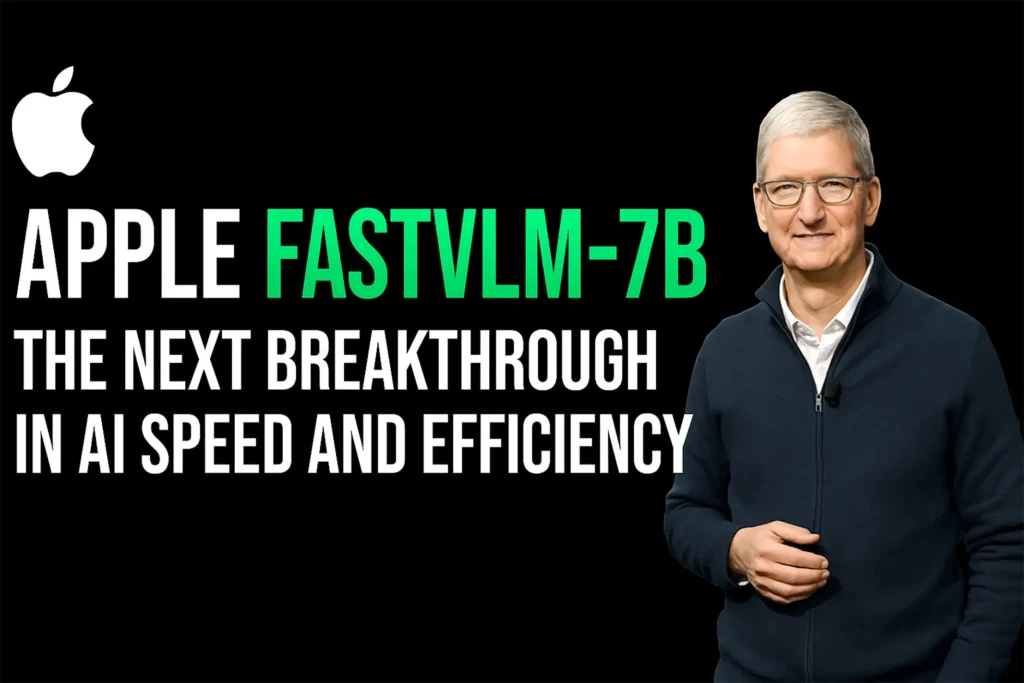The race to create faster and smarter artificial intelligence has taken a new turn with Apple’s FastVLM-7B. Instead of focusing on enormous models that demand vast computing power, Apple has delivered something lean, efficient, and practical for everyday use. This is not simply another step forward in AI research—it signals a fresh way of thinking about how intelligence should work across devices we rely on daily.
What Exactly Is FastVLM-7B?
FastVLM-7B is a vision-language model (VLM) designed to understand both words and images together. In practice, this means it can take a photograph and explain it, combine text with visuals to produce context-aware answers, or assist with tasks where visual recognition and natural language merge.
What sets it apart is not its size, but its efficiency. With 7 billion parameters, it is smaller than many headline-grabbing models but carefully engineered to deliver speed and accuracy without wasting resources. Most importantly, it has been designed to run on Apple’s own devices—from iPhones to MacBooks—rather than being locked inside massive server farms.
Why FastVLM-7B Matters
Apple has made deliberate design choices that give this model an edge:
1. Lightning-Fast Processing:
Time is everything in AI applications. FastVLM-7B is built to respond almost instantly, making it well-suited for real-time tasks such as live translation, AR experiences, and accessibility support.
2. Energy Conscious:
Unlike power-hungry competitors, the model works smoothly with Apple’s M-series chips, ensuring lower battery drain and sustainable performance.
3. Built for Multi-Modal Use:
Because it can handle text and visuals at the same time, it opens the door to more intelligent applications—from assistants that can “see” to tools that support complex creative workflows.
4. On-Device AI:
Perhaps the most important point: FastVLM-7B doesn’t rely entirely on the cloud. It can run directly on Apple hardware, meaning better privacy, security, and offline functionality.
The Technology Driving FastVLM-7B
Apple’s achievement rests on several smart technical choices:
- Streamlined transformer layers that handle information quickly.
- Sparse attention that only looks at the most important data points.
- Deep optimisation for Apple Silicon, ensuring smooth integration with devices.
- Compression techniques such as quantisation, which make the model lighter without reducing accuracy.
The result is a system that can do more with less, an approach that feels very much in line with Apple’s wider philosophy.
How Does It Compare?
Benchmarks suggest FastVLM-7B punches well above its weight:
- Speed: Runs up to three times faster than similar mid-sized models.
- Memory use: Needs significantly less VRAM, making it easier to deploy on smaller devices.
- Accuracy: Scores competitively in major vision-language tasks, proving that efficiency does not come at the cost of quality.
- Power draw: Uses almost half the energy of rival systems, an important win for consumer devices.
This balance of speed and economy makes it a realistic option for millions of users, not just researchers with access to advanced servers.
Where We’ll See FastVLM-7B in Action
1. Augmented Reality:
With Apple doubling down on AR through its Vision Pro headset, FastVLM-7B provides the intelligence to recognise real-world scenes and blend them with digital content.
2. Accessibility Tools:
For users with visual impairments, the model can describe objects, read written signs aloud, and provide environmental context instantly.
3. Smarter Siri:
Apple’s voice assistant has long lagged behind rivals. FastVLM-7B could finally allow Siri to become a truly capable, context-aware assistant.
4. Healthcare:
Doctors and specialists may use the model to analyse scans or medical imagery quickly, giving them an AI partner that enhances, rather than replaces, human judgment.
5. Robotics and Automation:
From drones to self-driving cars, systems powered by FastVLM-7B can make faster and safer decisions thanks to its real-time multi-modal processing.
Apple’s Unique Path in AI
Tech companies often boast about ever-larger AI models, but Apple has taken the opposite route. Its strategy is to make AI smaller, faster, and closer to the user. This has two clear benefits:
- Stronger privacy, since information can be processed locally.
- Broader adoption, because these models are built for everyday devices, not just enterprise solutions.
This direction could prove more impactful in the long term, as it prioritises practical use cases over record-breaking model sizes.
What Comes Next?
FastVLM-7B is only the beginning. The roadmap likely includes:
- More advanced versions, such as FastVLM-10B, with even sharper reasoning.
- Seamless integration with Apple Vision Pro and future AR hardware.
- Developer tools that let app creators harness its multi-modal intelligence.
- Expanded applications in education, healthcare, and accessibility.
The model lays the foundation for an era where AI isn’t locked in labs or servers—but embedded directly in the devices we use daily.
Conclusion:-
Apple’s FastVLM-7B is a reminder that AI progress isn’t always about size. By focusing on speed, efficiency, and usability, Apple has created a model that can reshape the way consumers interact with technology.
It is fast, light, and practical—capable of powering the next generation of AR, smart assistants, and accessible technology. With this release, Apple is positioning itself not just as a hardware leader but as a key player in the AI revolution.


2 Responses
I was wondering if you ever thought of changing the page layout of your website? Its very well written; I love what youve got to say. But maybe you could a little more in the way of content so people could connect with it better. Youve got an awful lot of text for only having one or 2 pictures. Maybe you could space it out better?
Thanks so much for the thoughtful feedback — I really appreciate you taking the time to share your perspective! 😊 You make a great point about layout and visuals. I’ve been considering a few design updates to make the posts more engaging and easier to read, including adding more images and better spacing. It’s always helpful to hear how readers experience the site, so your input definitely gives me something to think about. Thanks again for the kind words and for following along!